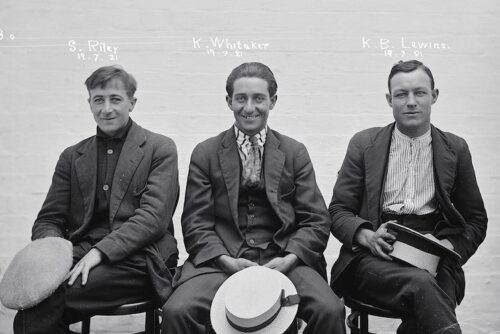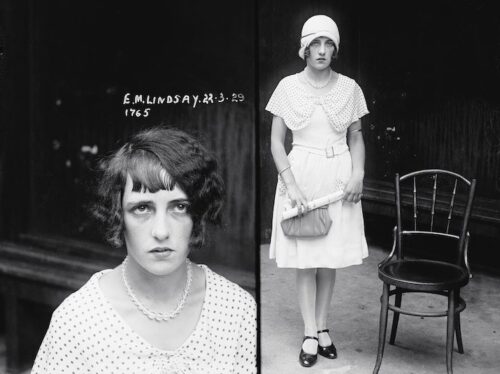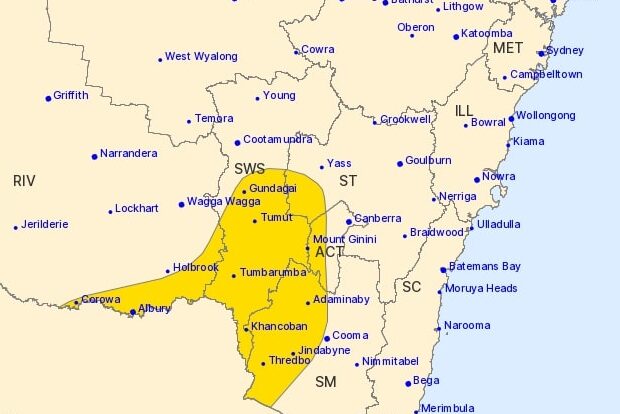 DAISY Buchanan and Elsie Parker coaxed a travelling salesman into their home, beat him up and stole his collection of petticoats, stockings and socks.
DAISY Buchanan and Elsie Parker coaxed a travelling salesman into their home, beat him up and stole his collection of petticoats, stockings and socks.
They hustled him into a taxi and dumped him at the bus stop.
But the women were acquitted of the crime because the salesman proved an unreliable witness.
Buchanan and Parker’s devious antics in Sydney 1930, led them to be captured in “raw and unexpected” mugshots by police.
A collection of candid photographs, featuring Buchanan and Parker, are on display at the National Archives of Australia as part of the exhibition “Underworld: Mugshots from the Roaring Twenties”.
On tour from Sydney Living Museums, the exhibition includes 130 photographs selected from more than 130,000 glass-plate negatives and digitally scanned.
The mugshots of cocaine sellers, sly-grog purveyors, and small-time crooks, from the NSW Police Forensic Photography Archive, offer a rare insight into Sydney’s criminal hierarchy in the aftermath of World War I.
“Most of us associate the 1920s with jazz, cocktails, art deco and good times, but this era also had a dark side,” exhibition curator Nerida Campbell said.

Campbell, who’s had a lifelong interest in deviance and crime, said the photographs shed light on the real stories of the plotters and petty criminals of this time, many of whom included women.
“Male gangsters are often given the spotlight or attention, but in the 1920s there were some incredibly dangerous and inventive female criminals running about,” Campbell said.
“This was the one period in Australia’s criminal history where we have two females kingpins or queen pins of the criminal world Kate Leigh and Tilley Devine, and there were many other women who were making lots of money, and had very violent sides to them, at the time.”
The mugshots, known as “Specials” are casual and intriguing portraits of suspects in custody and, unlike any elsewhere in the world, Campbell said.

Among the faces are “Cocaine King” Charles Passmore and Phil “The Jew” Jeffs, as well as underworld figure Kate Leigh, who ran sly-grog shops around Sydney.
Suspects smile, snicker, snarl or sneer at the camera, some even pose like movie stars.
“These photos don’t have any of the formal qualities that you’d expect from a mugshot where people look front and right, they are posing naturally, in their street clothes and using natural sunlight to illuminate their faces,” said Campbell.
“There are no bars or handcuffs in the mugshots that might give away that the person was in custody at the time the photo was taken.
“The idea was the police officer could take a crop of the person’s face and show it to a witness without prejudicing them against the suspect.”

The “unique” portrait style was created by police photographer George Howard who snapped his subjects complete with hats, pearls and handbags.
“Some of the men and women in the images have their hat on and hat off so that junior police officers who were walking beat could get to know who they should be keeping an eye on,” said Campbell.
“Often the photographs had a bentwood chair in the image, this was because the people in the images were still suspects and they didn’t want to have a height measurer in the photograph, any police officer worth his salt would see someone standing next to a bentwood chair and have a fair understanding of what height the person was.”
The stories of the suspects are as fascinating as the mugshots themselves.
Samuel Guy was a flasher, but is seen wearing his very loose trousers very high up his waist.
In other photos are joyriders looking bruised and bandaged, and returned soldiers such as Stanley Hay, are seen struggling to fit back into society.
“Stanley was a soldier who came back from the war as a lower-limb amputee,” said Campbell.
“He was charged with breaking into ‘Diggerville’ a workshop set up by the Commonwealth government to train ex-soldiers in trades.
“In court, police alleged that Hay had made off with five suitcases and four kit bags, but he was found not guilty, perhaps because of his war service they chose to be lenient on him.”

Typist Edna May Lindsay became known to police in 1929.
The 19-year-old was in love with a man who dreamed of being a dancer.
Hoping to fund their marriage and a new life touring the nation as dancers, Lindsay stole a cheque from her employer.
But she was arrested and received a suspended sentence alongside some advice from the judge that: “Dancing is not everything in life”.
“We see Edna in this poignant mugshot where she’s immaculately dressed as a 1920s flapper, in her hand she holds the summons papers for court, the devastation is written all over on her face and you can see a glimmer of a tear in her eye not knowing what’s going to happen to her next.”
Each mugshot has an attitude, be it good or bad, and shows a hint of each subject’s personality.
“The images are raw and unexpected,” Campbell said.
“You look at them and feel as if you have a connection with the person in them, there are no bland images, each one tells a story.”
“Underworld: Mugshots from the Roaring Twenties”, National Archives of Australia until October 24.
Who can be trusted?
In a world of spin and confusion, there’s never been a more important time to support independent journalism in Canberra.
If you trust our work online and want to enforce the power of independent voices, I invite you to make a small contribution.
Every dollar of support is invested back into our journalism to help keep citynews.com.au strong and free.
Thank you,
Ian Meikle, editor





Leave a Reply